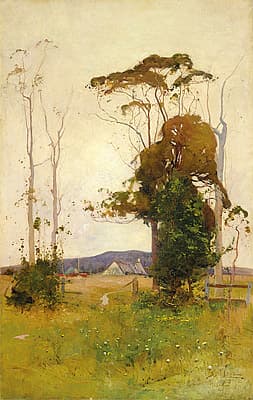
Sydney
LONG
Australia
1871
–
London
1955
England, Europe 1910-21; Australia 1921- 22; England 1922-25; Australia 1925-52; England from 1952
92.0 (h) x 59.2 (w) cm
signed and dated ‘SID LONG/ 1905’ lower right National Gallery of Victoria, Melbourne, The Joseph Brown Collection, presented through the NGV Foundation by Dr Joseph Brown AO OBE, Honorary Life Benefactor 2004
The year 1905, when Farm landscape was painted, was an important year for the 34-year-old artist. In January, ‘The trend of Australian art considered and discussed’, an article in which Long argued for a distinct Australian art, was published in Art and Architecture. Several months later, and somewhat at odds with this nationalistic agenda, he held an Art Union to raise funds to go overseas, a trip which did not eventuate at this time as the funds raised were stolen. By remaining in Australia while his contemporaries became expatriates, Long made a unique contribution to the development of Australian art. As Bernard Smith notes in Australian Painting 1788–1970 (p 104), the late 1890s saw the movement from impression to romance in Australian landscape, and it is in this later phase of the impressionist landscape that Long excelled, and of which Farm landscape is an outstanding example. The delicate elongation of the tree trunks, the soft light, the scattering of flowers in the foreground and the smooth handling of paint are characteristic of Long’s work at this time. The vista of hills, cottages and cows is peaceful, intimate and unremarkable; however, the exquisite tonal harmonies of tender greens, mauves and pearly greys give the work a poetry and authenticity. As the artist wrote in his 1905 article, ‘if the delicate relation of colour values is not there, all the swagmen and crows in Australia will not make it Australian’.
Elena Taylor
The year 1905, when Farm landscape was painted, was an important year for the 34-year-old artist. In January, ‘The trend of Australian art considered and discussed’, an article in which Long argued for a distinct Australian art, was published in Art and Architecture. Several months later, and somewhat at odds with this nationalistic agenda, he held an Art Union to raise funds to go overseas, a trip which did not eventuate at this time as the funds raised were stolen. By remaining in Australia while his contemporaries became expatriates, Long made a unique contribution to the development of Australian art. As Bernard Smith notes in Australian Painting 1788–1970 (p 104), the late 1890s saw the movement from impression to romance in Australian landscape, and it is in this later phase of the impressionist landscape that Long excelled, and of which Farm landscape is an outstanding example. The delicate elongation of the tree trunks, the soft light, the scattering of flowers in the foreground and the smooth handling of paint are characteristic of Long’s work at this time. The vista of hills, cottages and cows is peaceful, intimate and unremarkable; however, the exquisite tonal harmonies of tender greens, mauves and pearly greys give the work a poetry and authenticity. As the artist wrote in his 1905 article, ‘if the delicate relation of colour values is not there, all the swagmen and crows in Australia will not make it Australian’.
Elena Taylor
The year 1905, when Farm landscape was painted, was an important year for the 34-year-old artist. In January, ‘The trend of Australian art considered and discussed’, an article in which Long argued for a distinct Australian art, was published in Art and Architecture. Several months later, and somewhat at odds with this nationalistic agenda, he held an Art Union to raise funds to go overseas, a trip which did not eventuate at this time as the funds raised were stolen. By remaining in Australia while his contemporaries became expatriates, Long made a unique contribution to the development of Australian art. As Bernard Smith notes in Australian Painting 1788–1970 (p 104), the late 1890s saw the movement from impression to romance in Australian landscape, and it is in this later phase of the impressionist landscape that Long excelled, and of which Farm landscape is an outstanding example. The delicate elongation of the tree trunks, the soft light, the scattering of flowers in the foreground and the smooth handling of paint are characteristic of Long’s work at this time. The vista of hills, cottages and cows is peaceful, intimate and unremarkable; however, the exquisite tonal harmonies of tender greens, mauves and pearly greys give the work a poetry and authenticity. As the artist wrote in his 1905 article, ‘if the delicate relation of colour values is not there, all the swagmen and crows in Australia will not make it Australian’.
Elena Taylor
